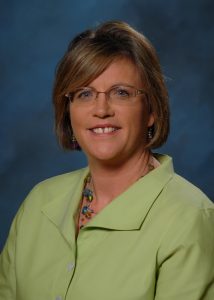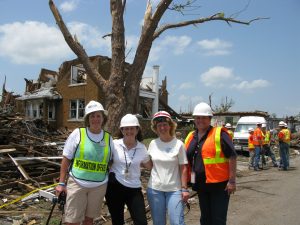Joplin
How PR helped a city recover from the costliest tornado in U.S. history
Published on March 12, 2020 at 9:16 p.m.
by Dylan Lanas
May 22, 2011
It’s Sunday in Joplin, a small city in southwestern Missouri with a population of a little over 50,000. Clouds cover the sky but life continues as usual. Some people watch the ongoing Cardinals baseball game on television, and others celebrate the end of another school year.
Lynn Onstot, Joplin’s longtime public information officer (PIO), is driving her two daughters and a boyfriend of theirs to get frozen yogurt after a sports banquet.

Instincts suddenly make Onstot turn the car around. The area they avoid — 20th and Rangeline — would be ravaged by an EF-5 tornado in about an hour.
Luckily for Onstot, this is as close as she and her family would get to the costliest tornado in U.S. history. Sheltered in the city hall’s basement, Onstot and her daughters dodge the nearly mile-wide and 13-mile-long path of destruction that would bring veteran weather reporters to tears and take the lives of 161 people.
At this moment, Onstot’s duties expanded beyond Joplin — the nation now watched the city’s next move.
It can be easy to focus on the tornado, the lives lost and the status of the city. However, at the heart of Joplin’s post-tornado story is a lesson in crisis communication that PR professionals can learn from.
Accuracy and consistency
After the tornado, Onstot began the recovery process by delivering facts to the news media.
“Oftentimes, the worst-case scenario is shown. People crying and not well-versed with a microphone become the face of your city,” Onstot said. “We wanted to stress the facts.”
One of the first things Onstot created at the city’s emergency operations center (EOC) was a fact sheet to be used for a 5:30 a.m. press conference the next day.
When meeting with media, Onstot recommends limiting messages to three main points as people tend to forget any additional information.
The questions Onstot faced the morning after the tornado needed basic information: safe places to go, establishing a phone line, and providing immediate search and rescue updates. It was in the days afterward as national coverage heightened when Onstot began emphasizing the need to have relevant, concise answers.
With the growing desire for specific information came the need for consistent messages.
Lane Roberts, Joplin’s police chief at the time, credits Onstot and the city for running an operation that encouraged this cohesive information at all levels.
“When the message is not consistent, it becomes a big deal,” Roberts said. “Lynn worked really hard to mitigate differences.”
One of the ways Onstot maintained this consistency was by directly confronting unverified information, particularly from the internet.
“Many times Lynn would go to local radio stations and play rumor control,” Keith Stammer, director of emergency management, said. In these cases, Onstot would go on air and give the official account of what was happening in the city.
Onstot handled on-screen media relations in the days immediately after the tornado. However, City Manager Mike Rohr took over duties as the primary spokesperson. This transition allowed Onstot to focus on written communication needs and also gave Joplin a consistent face for the media to cover, a PR practice best used in all industries.
Empathy and openness
However, accuracy is not the only integral part of effective crisis communication. Organizations must be sensitive to their publics’ needs and know when to ask for assistance.
“Typically in a disaster, you can lean on similar departments in your city for help,” Onstot said. “In this case, there were no things like that left. We needed to look outward.”
Stammer reached out for help from nearby Greene County, which offered its own PIOs and resources that aided Onstot and others in the EOC. FEMA arrived on the scene a few days after the storm. Onstot worked with seasoned external affairs officers, and she was grateful for the disaster experience they shared with her.
Crystal Payton was among these FEMA responders. She was deployed to Joplin after responding to the Alabama tornado outbreak a month earlier. Despite the destruction around her, Payton remembers her experiences with Onstot fondly.
“One of the things I really saw Lynn demonstrate daily was an inclusive and open operation that welcomed everybody,” Payton said. “Lynn and the city’s focus on keeping the community together is one of the things that impressed me so much.”

Combining a detail-oriented approach to information with a persistent drive to keep the community together, Onstot and the city of Joplin created a space that allowed quick recovery despite such an extreme event.
“Lynn was a pleasure to work with,” Roberts added. “She was sensitive to the needs of the work we had to do and found a good balance between her role with the city and our role as law enforcement.”
Long-term efforts
Almost a decade later, the tornado’s legacy remains in Joplin both physically and mentally. In crisis communication, the effort necessary to undo a disaster’s effects is often much larger than what it took to begin with.
Jane Cage leads a team of community volunteers — the Citizens Advisory Recovery Team, aka CART — who still continue tornado-related outreach today. While Onstot never handled CART’s communications directly, Cage and Onstot have worked together for anniversary events. This collaboration often takes the form of sharing city records and documents related to the storm.
Cage said that the two are working on an ongoing project to make a digital compilation of Joplin tornado coverage. Currently titled the Joplin Hope Project, Cage and Onstot’s project seeks to provide a convenient, extensive record for researchers.
With the Joplin tornado’s 10th anniversary coming soon, Cage is hopeful Project Hope can also tie into what could be a widely covered event.
One of the key steps to good crisis management is evaluation. Serving as the media contact for essentially all content that Joplin released after the storm, Onstot’s presence is an understated yet constant characteristic of the city’s press coverage.
Perhaps the upcoming anniversary can serve as the perfect chance to show just how important communication is for dealing with a crisis.




